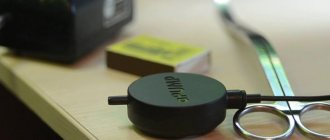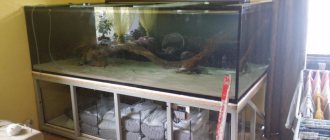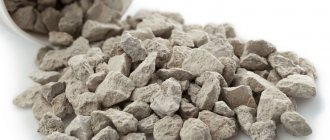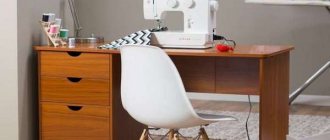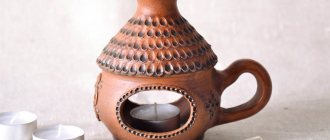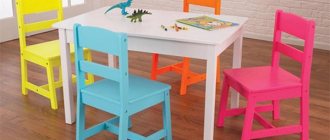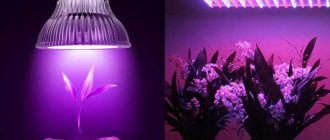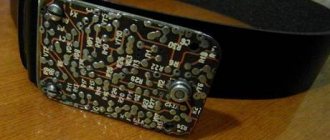A beautiful and large aquarium in the house is a stylish addition to the interior, helping to create a unique and cozy atmosphere. A living area with a complex ecosystem requires special care, and a do-it-yourself aquarium cabinet will be an excellent addition to the arrangement.
A stable and practical piece of furniture ensures that the tank is installed in one position and will facilitate maintenance procedures. Before starting the creative process, you should carry out detailed preparations, select a project or draw it up yourself, and prepare materials.
Making a stand for an aquarium with your own hands: what to especially pay attention to
Hi all! Many people dream of having a beautiful aquarium at home. But not everyone knows that such a mini water world requires special furniture on which the tank will stand.
Today I propose to talk to you about how to make a cabinet for an aquarium with your own hands, what is required for this and what important nuances are involved in the manufacture of such a piece of furniture.
The main emphasis should be placed on the fact that the cabinet is expected to be exposed to a large load. Even small aquariums weigh quite a lot, and therefore ordinary tables or bedside tables cannot always be used as furniture for an aquarium.
The easiest option is to purchase a ready-made design from manufacturers. But the factory stand is very expensive, and it does not always meet the expectations placed on it. That’s why many people prefer to take production into their own hands. In fact, making a cabinet is not difficult. You just need to perform a few steps, while being extremely careful and attentive.
Purpose
When purchasing a cabinet specifically for an aquarium, regardless of its volume, you should take into account that it will simultaneously perform several functions:
- serve as a support for a home mini-reservoir;
- serve as a repository for accessories necessary for maintenance (nets, compressor, containers with food and similar little things);
- used as an element of interior design, serving as part of a partition that forms several functional zones in a living space;
- be a decoration of the recreation area;
- perform specialized functions for persons professionally engaged in tropical fish breeding.
Material selection
Before making drawings, decide on the material that will be used for your cabinet. Here you should largely rely on the size of the aquarium itself, since tanks of 100 liters, 200 liters and even huge tanks of 300 liters can be used. And this, as you understand, is at least 300 kilograms of water alone. Add here various additional equipment and content, and you get a huge number.
And the cabinet must withstand all these kilograms. It is logical to assume that your bedside table or coffee table will not be able to withstand such a load.
The heavier the tank, the higher the requirements for the reliability of the material used. When creating such structures, they usually use:
Whether you make the structure from wood or from timber, from chipboard with a laminated surface or from metal, it’s up to you. But, as practice shows, a frame made of metal profiles, covered with wood or chipboard, looks great and serves well.
The material will not only be subject to weight loads, but will also begin to constantly come into contact with water. That is, the choice of material must be made with an eye to ensuring that it is moisture resistant.
Characteristics
Let's look at the main qualities that are important for an aquarium. Its glass should transmit light well without distorting the surface - this is indicated by light transmittance. A certain resistance to loads and impacts is also required - let's talk about strength. And the walls of the product should easily hold the entire volume of poured water. More on this later.
Thickness
The more spacious the future aquarium is planned, the thicker sheets of acrylic glass must be used. But this is not done by eye, but by calculation. On the Internet you can find special calculators where you need the size of the water column. At the output we obtain the required thickness of the material. Or you can contact specialists who will make accurate calculations. We take into account that the maximum water pressure (safe) is no more than 3 MPa.
Here are the most commonly used standards:
- For a product with a capacity of no more than 30 or 40 liters, you need a sheet of plexiglass no thinner than 3 millimeters.
- More substantial aquariums (up to 80 or 100 liters) require a thickness of at least 4 millimeters.
- Sheets 6 mm thick are used for volumes up to 200 liters.
- If the capacity of the future aquarium is more than 200 liters, then you will need acrylic glass from 8 to 16 millimeters thick.
Light transmittance
This parameter for plexiglass is 92 percent. This is the same level as silicate glass. But it is worth noting that the latter has a slightly greenish tint, almost invisible in the air. But when you look through glass walls at the inhabitants of the underwater world, the color spectrum is slightly distorted (a little green is added).
Transparent plexiglass has a refractive index almost equal to water . This allows you to see the world inside the aquarium absolutely without distortion, in all its natural colors. After all, a ray of light is refracted only twice.
Strength
We all know how fragile silicate glass aquariums are. When hit hard, they are unable to resist - the fragments along with the water scatter in all directions, and most of the fish die. However, this is also fraught with injury for humans. Organic glass is much more resistant; it is not broken even by a billiard ball (there have been such cases). As a rule, the impact leaves only scratches that can be removed later.
Naturally, acrylic glass also has a tensile strength. However, the result is not so critical. The cracks on the walls do not go any further: you can manage to save the inhabitants of the aquarium from death, scoop out the water, and avoid getting injured. This way you will be able to avoid the wrath of your neighbors below, and the fish will remain alive and healthy.
Design
You can take diagrams from the Internet, look for suitable drawings, repeat the manufacturing and assembly procedure using photo and video instructions, or do everything from start to finish with your own hands.
If you do not have experience in making such cabinets, it is better to work with some samples and visual aids, so to speak.
The most popular are 200-liter aquariums, for which a cabinet is made on a rigid frame and covered with sheets of laminated chipboard. Financially, this is the most profitable option, plus the material itself is not afraid of moisture.
Pure metal does not look very aesthetically pleasing, weighs a lot and is expensive. Wood is also expensive, and its moisture-resistant properties are significantly inferior to those of laminated sheets.
As for size, there are several factors to consider.
- The optimal height is considered to be 60-70 sizes. This will allow you not to bend too much, but at the same time not to place the aquarium too high;
- When calculating the height, do not forget about the presence of legs on the cabinet;
- The width directly depends on the size of the tank itself;
- Cabinets whose size is equal to or literally slightly larger than the size of the tank look beautiful and neat;
- If this is an aquarium with a capacity of more than 200 liters, it is highly advisable to make a separate cabinet with a reinforced frame;
- You should not make furniture wider than the container in order to use the space for other things. A more rational solution here would be to install shelving, as well as store things in the cabinet itself.
Please note that the aquarium is an independent piece of furniture in your home. Therefore, you should not use the cabinet as a place where you will store your socks or some tools.
The bedside table is dedicated strictly to the needs of the aquarium. That is, you need to place food there, equipment for filtration and cleaning, and everything else that is directly related to the aquarium and its contents.
Main indicators of practicality
In addition to its pleasant appearance, do not forget that the bedside table for the aquarium must perform a number of functions included in it by the manufacturer. To do this, there is a list of criteria that determine the practicality of the product:
- moisture resistance - each material used in the design of the product must not absorb moisture. The constant use of fish food, the procedure for cleaning the tank and other manipulations lead to water flowing onto the cabinet. Manufacturers try to additionally treat chipboard and MDF with compounds that prevent moisture penetration;
- tendency to deformation - among furniture products there are also those that can crumble into pieces with a slight impact. Keep in mind that the aquarium is heavy, and during operation the cabinet should not deform under load;
- strength - the back wall of the product must be reinforced with metal racks. Using fiberboard alone will not be enough if you plan to use a 200 liter aquarium with a stand. It is best if not only the rear pillars, but the entire product is equipped with metal inserts;
- holes for cords - it’s a good idea if the future bedside table is equipped with additional openings for power cords and tubes. For example, it is very convenient to place a corner aquarium on such a product: you will not need to look for a way out of the situation where to place the protruding connections to the tank;
- doors - think about the fact that all the equipment for feeding and caring for the fish needs to be located somewhere. Most likely, these will be shelves in a cabinet, so it is better that the doors cover them.
It is also worth paying attention to the thickness of the tabletop, on which the stability of the bedside table will depend. The photos presented in our material show that this value should not be small
Taking into account the main strength indicators, you can proceed to choosing a model.
Design elements
It cannot be said that the process of making a cabinet designed for an aquarium is very different from assembling the same chest of drawers. You will have to make drawings, determine dimensions and manufacture components.
In this case, the aquarium cabinet includes several main components.
- Back wall. Here you need to make it as strong and reliable as possible. Therefore, take material with a thickness of at least 22 mm. Typically, chipboard and MDF sheets are used. It is important to understand that the back wall will bear the main load, make the furniture stable and will not allow it to settle under the large mass of the tank. If you build a rear partition between the side partitions, the structure will be even more durable;
- Frame. The internal vertical walls are placed at intervals of about 25 centimeters from each other. They will make the tabletop more stable and will also take on part of the load;
- Tabletop. It is considered one of the most important elements of a bedside table. Be sure to choose smooth, durable and moisture-resistant materials;
- Doors. It is unlikely that you want the entire contents of the cabinet to be in the open position. Therefore, it is worth installing doors on hinges with closers. Do not forget to make markings on the side partitions for the installation locations of the door hinges;
- Legs. You can do without them. It all depends on the diagram and drawings. But it is better to make stable legs from strong and durable material. Aluminum performs well here. Rubber pads won't hurt to avoid scratching the floor.
Everything about the design is very clear.
All that remains is to figure out how to assemble all these components into a single whole in order to be able to install the aquarium itself, connect it and start using it.
Assembly
The next stage of creating an aquarium product is to assemble the resulting elements, which are components of the structure. This process is considered quite specific, so it is recommended to use the help of a second person, since certain heavy objects will need to be kept suspended for a long time, and it is impossible to perform these actions alone.
The entire assembly process consists of implementing sequential actions:
- special grooves and ridges are prepared for the rear wall, for which they are cut with a saw or electric jigsaw;
- the same elements for fastening are made in the bottom of the future bedside table, in its sides and lid;
- two parts of the upper corner of the rear part of the product are glued together, and the resulting workpiece will be mounted behind a special module designed to create high-quality lighting;
- the planks are tightened with clamps, after which you need to wait until they are completely dry;
- special plinth bars are screwed to the bottom of the cabinet, and to form them it is recommended to use high-quality and properly dried wooden blocks, the thickness of which will be more than 40 mm, since it is on them that the entire cabinet with a heavy aquarium will rest;
- plates are screwed to the inner sides of the side walls to secure the middle cover;
- the front edges of each part must be installed so that they are level with the edge of the middle cover and bottom of the product;
- then take the internal central partition, which is glued to the middle lid and bottom;
- the back wall is inserted into the corresponding groove in the bottom;
- one side wall is attached to the bottom, after which it is fixed to the middle lid, for which dowels and high-quality glue are used;
- the back wall is connected to the side using the existing grooves and tenons;
- a corner is attached to the top of the sidewall, for which dowels set with glue are also used;
- it is on this corner that the upper part of the product will rest;
- the second side of the bedside table is attached in the same way;
- the following steps involve assembling the upper frame of the structure;
- interesting lighting is installed in it;
- the resulting box is fixed to the bedside table, and for this it is recommended to use piano hinges, since they make it possible in the future to simply fold back this box if necessary.
Thus, building a special bedside table designed for an aquarium is quite simple, and this process does not take much time if you approach it really responsibly. It is allowed to use other materials during work, and the procedure will be similar, but the methods of preparing different parts will differ.
Manufacturing procedure
The shape of the cabinet can be straight or angular. Rely on the size and shape of the tank itself for aquatic life. The corner option is suitable for those who want to use additional space, or who have a corner container itself.
We are talking about a standard rectangular model. Manufacturing is not the most difficult, but you need to adhere to certain rules.
Tools you will need:
- milling cutter;
- drill;
- screwdriver;
- screwdrivers;
- grinder or circular saw;
- paints and varnishes and means for their application.
Then everything happens in stages, starting from the preparation of materials, ending with the installation of accessories and the placement of the aquarium itself.
In practice it looks something like this.
- First, the material is cut into the necessary parts. If you don’t have tools for cutting and milling, you can contact a workshop or furniture shop. The service is not the most expensive;
- Frame assembly. This is the first stage of assembly. For the frame, timber or metal slats are used. Correct assembly of the frame guarantees the stability and strength of the entire cabinet. Avoid tilting and unevenness. Everything is strictly according to the drawing;
- Tabletop. Experienced furniture makers advise installing it sequentially. First, a pair of holes are made in the corners diametrically opposite to it. Next, the level is leveled. If everything is smooth, the tabletop is screwed on. There is no need to make pre-holes;
- Horizontal shelves, drawers and doors. We can say that this is practically the final stage, since here we are talking about the practicality and functionality of the aquarium cabinet. Use high-quality fittings and always stainless steel. There will be moisture around, and therefore rust can quickly ruin your efforts;
- Legs. When the cabinet is assembled, it needs to be laid on its side, which will allow you to install the legs themselves. They are mounted along the edges of the structure to prevent subsidence and deflection. The legs are additionally equipped with pads to avoid unwanted scratches on the floor.
Which glue to choose
To attach parts, you need to choose a special glue designed for aquariums. The most popular is silicone. It comes in three colors - white, black and transparent.
The first option is rarely used, as it can spoil the appearance of the interior. For large-volume containers, choose black, which will emphasize the sophistication of the design. For small aquariums, transparent silicone is suitable.
Professional advice for decorating an aquarium is not limited solely to the external design of the structure.
It is important that aquarium silicone glue meets the following requirements:
- provided fastening strength and was elastic;
- did not have harmful impurities, antifungal and antibacterial additives;
- retained its original properties and appearance over a long period of operation;
- dried quickly;
- provided the required level of adhesion;
- was easy to work with.
How to make an aquarium table
We will create an aquarium table with our own hands from materials available in most stores. You will need a good knowledge of the internal structure of aquariums.
By the way, here’s another master class for you: a do-it-yourself aquarium lid! Try making it yourself. Let me know in the comments if it worked for you.
We will need:
- Aquarium for 76 liters of water
- Fluorescent lamps 2 pcs. (70 cm each)
- Mirror table cover
- Extension
- Thermometer
- Light timer
- 4 packs of chair tips
- Wire rack measuring 91 cm by 36 cm
- Black foam
- Water heater 100 V
- Internal filter for 76 liters of water
- Glass beads or transparent pebbles
- Triple adapter
Please note that the structure must support more weight than the nominal volume of the aquarium.
Step 2: Bottom of the Shelving
Many shelving units have the ability to adjust the height using collapsible posts. 36-46 cm is suitable for us. If you cannot purchase the option we need, then buy a large rack and use a hacksaw.
Step 3: Light
Consider in advance where the cable from the fluorescent lamps will go. In our case, everything is located under the rack. Use an adapter and a light timer in the process.
Step 4: Aquarium
We place an aquarium inside the rack. Its size may be slightly less than the height of the shelf for convenience when feeding fish (no need to remove the mirror cover).
Step 5: Top Shelf
Using wire cutters, remove the top shelf of the rack if it cannot be removed without using a tool. As a result, we should only have side and front fences left.
Attach the chair ends to the 4 support posts of the shelving unit.
Step 6: Decor
You may need to install a water heater if you need temperatures above room temperature, as well as an underwater filter. Install them and place the wires under the shelving. After adding water, you can turn on these devices.
Attach the thermometer tube using a suction cup.
Place glass beads in an even layer on the bottom of the aquarium.
Step 7: Completion
Close the lid of the aquarium and place the mirror surface of the table on it.
To hide wires and electrical equipment, place dark foam underneath like in the picture.
Now you can take care of the flora and fauna of the aquarium itself so that the fish are comfortable.
Aquarium table: interior decoration ideas
join the discussion
Share with your friends
Thanks to the advent of transparent polymers and tempered impact-resistant glass, a unique opportunity has opened up to create unusual pieces of furniture for a modern interior, among which the aquarium table is extremely popular. It allows you to view the underwater picturesque world right in the middle of the room; the coffee table with fish looks especially chic. This design can be easily made with your own hands from plastic pipes.
What is
Bedside table made of wood: varieties and making it yourself
A vessel with water, modified into a cabinet, coffee table, bar counter - this is an aquarium table. Can be made in the shape of a rectangle, square, circle or oval. The most reliable are simple rectangular models with wooden stops. This piece of furniture will become the highlight of the interior. The following types of fish can live inside the product:
- guppy;
- zebrafish;
- neons;
- telescope fish;
- goldfish.
You can diversify the life of unpretentious creatures with plants, structures, and decorations. An integral part of the aquarium table is the removable lid. After all, pets need to be fed and the product needs to be cleaned. A home pond is suitable for a classic, Mediterranean, oriental interior. An aesthetically pleasing design serves several purposes:
- live scenery;
- has a calming effect;
- transforms the interior;
- improves the microclimate.
Aquarium tables presented in stores are sold in different shapes and styles. Simple glass rectangular options are appropriate in minimalism, models with luminous neon stripes are suitable for a high-tech interior. There are also luxurious aquarium tables with gold patterns for Baroque and Rococo rooms.
The products have disadvantages:
- fish are shy, sudden movements disturb their peace;
- pets and their habitat require care;
- equipment is necessary for the normal functioning of fish.
Peculiarities
A glass table with fish is a multifunctional piece of furniture that allows you to conveniently keep animals in the house and acts as an unusual accessory in the design of the room. Today, a tabletop aquarium can either be purchased in furniture stores to order, or you can assemble it yourself with your own hands. At the same time, the latter option is more popular, as it allows you to make various designs and choose a design at your personal discretion. The aquarium table has the following advantages:
- suitable for placement in any room, including not only residential buildings, but also business centers, beauty salons and offices;
- low maintenance - it should be used like a regular aquarium on a cabinet, that is, do not place cups with hot drinks or lay out food;
- goes well with other interior items, regardless of the style of the room;
- maneuverability - it can be easily rearranged and transported;
- availability to produce various models using various shapes and sizes;
- the ability to equip with additional elements such as decorations and lighting.
Place in the interior
Even the simplest aquarium placed in a room can attract attention and fill the space with an unusual atmosphere. As for a table that looks like a transparent vessel with fish, it will not only transform the interior, but give it some chic. This is explained by the fact that the design is not an ordinary coffee table made of chipboard or wood, but a real masterpiece with living sea creatures inside.
This aquarium table can be installed in any room, from the living room to the kitchen.
At the same time, it looks best in the interior of living rooms, where you can watch the water kingdom right on the sofa.
In order for this stylish accessory to harmoniously combine with all decorative items, it is important to pay attention to its internal design and geometric shape. Depending on the size of the room, you can buy an oval, round or rectangular table for your office or living room. In offices and hotels where there is a lot of space, a huge rack-style tank with a built-in aquarium is a good choice.
Such an interior will not leave anyone indifferent. At home, it is beneficial to emphasize the originality of this type of furniture with bright lighting and beautiful interior design of the aquarium.
In living rooms and bedrooms, the aquarium table can be placed either along one of the walls or in the center of the room. If the aquarium is large, then it should be filled with large plants and placed on the side so that it covers the entire wall. The same applies to fish; for the interior of living rooms and dining rooms, it is advisable to purchase them with bright and contrasting backs.
The aquarium table in the interior of kitchens deserves special attention; it allows you to enliven a strict style and promotes relaxation.
How to do it?
To create a modern design with a mysterious effect, it is enough to install an aquarium table in the room, which you can buy ready-made or make yourself from scrap materials. If the latter option is chosen, then it is necessary to prepare not only building material, but also tools. In addition, the master needs to have a good knowledge of the internal structure of the aquarium.
To make a basic plastic pipe structure, you should have on hand an extension cord, a 76L aquarium, a mirrored countertop, lights, a thermometer, a light timer, 4 pipes, black foam, a shelving unit, and an internal filter.
For decoration, you will have to additionally stock up on transparent pebbles or glass balls.
The workflow itself will include several steps.
- Decoration of the bottom of the rack. Since most racks are equipped with the ability to adjust the height using disassembled columns, it is advisable to purchase products with adjustable tubes from 36 to 46 cm in length.
- Installation of the lamp. The passage of cables from fluorescent lamps should be provided in advance. And also additionally connect a light timer and an adapter.
- Installation of a glass container (aquarium). It is placed inside the rack. To make it more convenient to feed the fish without removing the mirror cover, the size of the aquarium should be slightly less than the height of the shelf on the rack. Then they proceed to the top shelf, it is removed using wire cutters. The end result is a structure with front and side guards. 4 tubes are attached to them.
- The finishing touch is the decor of the aquarium table. To do this, install a water heater inside the container (if the water temperature is required above room temperature) and a double filter. Wires from installations should be located under the racks. The thermometer is attached to the wall using a suction cup and glass beads are poured into an even layer on the bottom. At the very end, the lid of the aquarium is closed and a table top with a mirror surface is placed on top.
- All that remains is to start populating the aquarium. To do this, flora and fauna are placed in it. If other accessories are required, they are also placed in the aquarium. The main thing is that the fish are comfortable.
Preparation of the drawing
Before the actual work, it is important to make a special drawing according to which all stages of the process are implemented. If you do not have the skills to independently draw up drawings and diagrams, you can use special programs, and it is also possible to find suitable ready-made drawings. During the creation of the drawing, the main issues regarding the future design are resolved:
During the creation of the drawing, the main issues regarding the future design are resolved:
- dimensions, and they must be optimal so that you can easily install an aquarium of a certain shape and dimensions on the product;
- shape, since it can be a standard cabinet or corner, as well as triangular, rectangular or asymmetrical;
- height, and it is advisable to choose this parameter in such a way that the process of cleaning and changing water in the aquarium is simple and does not require removing the product from the stand.
Once the drawing is completely ready, you can begin the actual process of creating such a bedside table.
How to make an aquarium table from wooden pallets
The author of the homemade project had a problem where to install the aquarium, which he loves very much. A large aquarium requires a good, strong support, as you understand, this is quite a lot of weight. In a store, such a table would cost the author from 75 to 300 dollars or more. In this regard, it was decided to make it with your own hands from practically waste, free materials.
The material used was old wooden pallets. In most countries you can get them for free. As a rule, such pallets contain a lot of boards, blocks and other useful material. The most important thing is to choose such pallets that they are not rotten, broken, etc.
Materials and tools used by the author:
List of materials:
– wooden pallets; - door hinges; – door handles; – wood screws, etc.; – strong wooden beams for making the frame.
List of tools:
- a circular saw; – roulette; – marker; – screwdrivers, pliers and other hand tools; – oil for impregnation (or paint if desired).
Table manufacturing process:
Step one. Making a table frame
Unfortunately, the author did not take many photos of the making of his table. But this is not so scary, because the design is quite simple. The first step is to make the frame; it must be very strong, since the table must withstand a weight of more than 200 kilograms, which is exactly how much the author’s aquarium weighs.
To make a frame, boards from wooden pallets are not suitable; here you will need strong beams. First of all, figure out how long and wide your table should be, and then cut the required number of blanks. In fact, you have to assemble two rectangles, one located at the bottom and the other at the top. Well, you will also need four bars to connect them. These are the main parts of the structure.
Also, for additional strengthening, you can cut short transverse bars.
Once you have cut the required number of pieces, start assembling the frame. Everything is assembled using wood screws. We drill holes for them and then screw them in with a screwdriver. In principle, this is the simplest and most reliable connection method. After assembly, check with a level that everything is level, otherwise the table will stand crooked, and most importantly, that it does not wobble with the aquarium.
Step two. Making a countertop
The table top should also be as strong as possible. For these purposes, the author makes it two-layer. The first layer is made of plywood. We find the required piece and cut out a rectangle from it in the shape of the table. Well, then we attach the plywood to the frame. Here you will need screws and a screwdriver. Do not skimp on the number of screws, thanks to them not only will the plywood hold well, but the frame will also become even stronger due to the rigidity of the plywood. Tighten the screws well so that the caps do not stick out.
Next we make the second layer for the table top. It is made from boards. This layer also gives rigidity, but it also has an aesthetic meaning. We make the second layer from pallet boards. If you wish, you can choose boards of various colors and form a beautiful pattern. The boards must be the same thickness, otherwise you will have to plan them. We align the edges of the boards using a circular saw so that they fit together well and do not form cracks. Sand both sides of the board until smooth.
Once you have prepared the boards, you can fasten them in place. The easiest way is to attach them with glue, since the heads of the screws will spoil the entire aesthetics. Apply wood glue, press and leave to dry. When the glue has dried, sand the surface thoroughly. It should become absolutely smooth and even.
Step three. Making side walls and bottom shelf
The bottom shelf and side walls are made in much the same way as the table top, although the requirements here are not so strict in terms of uniform thickness and so on. But it is desirable that everything be smooth. We cut off the required number of boards, sand, level and sheathe the side parts. For fastening, you can also use glue, or self-tapping screws.
As for the bottom shelf, to form it we attach boards from the inside of the frame. This whole thing is made in a similar way. Finally, we sand the shelf so that it is even and smooth.
Step four. Finishing the front part and installing the middle shelf
According to the author's idea, there will be cabinets with doors on the sides of the table, and an open shelf in the center. First of all, we install two partitions; they will simultaneously divide the inside of the table into three compartments, and the central shelf will also be attached to them. The partitions themselves are made of boards; to secure them you will need four blocks. We fasten the beams at the top and bottom, each wall is supported by two beams. For reliability, the bars can be screwed with self-tapping screws, especially since they will not be visible. Well, the walls themselves can be glued.
Boards are used to make the central shelf. Select the required number of boards by color, cut them and glue them to the partitions. However, the glue will not be a reliable fastening; it is better to screw the blocks to the partitions and install a shelf on them.
At the end, all you have to do is cover the front of the table with multi-colored boards. I think you won’t have any difficulties in this regard. The most important thing is to do everything smoothly and accurately. Boards can be glued.
Step five. We make and fasten doors
You will need two doors in total; they are made from boards and are not difficult to make. First we prepare the boards, sand them, level them, and then connect them. In principle, if you have good wood glue, you can simply glue the boards end-to-end. But it is best to glue or screw the blocks on the inside, this will make the doors guaranteed to be reliable.
To secure the doors you will need four door hinges. When choosing hinges, take into account the weight of the doors so that the hinges do not bend. For convenient use, install handles on the doors. We fasten the doors into place using self-tapping screws.
Step six. Finishing touches
Finally, you can cover the back with boards, but the author did not need to do this, since his adjacent wall is finished with boards.
It is also extremely important to protect the wood from moisture, which is very abundant near the aquarium. Moisture can cause serious damage to wood, such as deformation, cracking, and so on. To protect the wood, it must be impregnated with oil; oils now come in a variety of colors, so you can choose any one that suits you. In general, it is customary to use linseed oil to impregnate wood, and it is best if it is boiled, that is, natural drying oil. It is better not to use artificial drying oils, as they are harmful, smell strongly, and are expensive.
Tips for making a stand for an aquarium with your own hands
The underwater world and its inhabitants are like a fairy tale for land creatures. The play of light in the water, the glare on the scales, the rapid strokes of fish of different colors and shapes - all this fascinates and captivates. But the larger such tanks are, the more difficult they are to operate. This applies not only to the artificial house, but also to the furniture around it. In particular, cabinets for aquariums require especially careful selection.
If an aquarium cabinet takes up a lot of space, it must be functional
Design
The lion's share of aquarium stands are made from MDF board, which is not so susceptible to moisture. Due to the abundance of textured and color finishes, the aquarist will always be able to choose a product that fits particularly elegantly into the existing interior style:
- samples painted in beige and white colors can be placed in the bedroom or kitchen;
- products lined with a “wood look” (for example, light or dark Shimo ash) will fit perfectly into any living room design;
- Always a fashionable classic - bedside tables painted in plain, dark undertones will create a more comfortable environment in the interior of the study;
- multi-colored cabinets, painted in intense colors, will decorate the nursery.
Types of aquariums and stands for them
It is not always possible to buy a suitable bedside table, because there are a great variety of aquariums, from very small ones of 10-15 liters to giant ones of 1000 or more liters. If you plan to keep more than one fish, but several species, but there is a problem where to place the container, a volume within 100 liters would be a good option.
The larger the size of the future aquarium, the more possible shapes it can have:
- cylinders;
- cubes and forms close to them;
- parallelepipeds;
- prisms with different bases;
- sickle-shaped.
The types of tables or cabinets will differ depending on the chosen aquarium configuration. For example, for a triangular prism, corner stands are good, and for a cylindrical flask, round or square ones with a side equal to or slightly larger than the diameter of the tank.
Aquarium manufacturers do not always provide a stand with it. Therefore, lovers of the underwater world have to make aquarium cabinets with their own hands or order them from a carpentry workshop, since not all furniture can withstand such an increased load.
If you liked the video, share it with your friends:
Dimensions
How to make a box with your own hands?
The size of the cabinet is directly related to the size of the aquarium. The tank is glass, so any distortion or overhang can cause uneven distribution of loads. This situation always ends with the appearance of cracks and destruction of the housing. The main supporting element is the tabletop or upper platform. The successful installation of an aquarium of one size or another depends on its size and shape. It is customary to conventionally distinguish between three types of furniture:
Small ones. These usually include models that can withstand containers with a capacity of 70–100 liters. The length of the supporting platform is 0.6–0.7 m with a depth of about 0.3 m. Average. On such models you can install an aquarium with a capacity of 120–150 liters. Their length can be 0.7–0.8 m, width - 0.3 m. Large. These are stands for large tanks with a volume of 200 l to 300 l. The minimum height of the reference plane must be 1 m
It is important to ensure sufficient strength of such a cabinet, since the load will be very large. Any distortion or sagging can cause destruction of the aquarium with dire consequences.
Not only individual cabinets are produced, but also entire sets consisting of 3 tiers:
- lower - supporting structure;
- middle - the tank itself;
- the top - a lid combined with mezzanines.
Usually the capacity of such kits is very large. To ensure reliable support, the design includes additional reinforcing elements and stiffeners. The dimensions of such models are quite large, in length - from 1.5 m, in height - from 1.3 to 2 m. To install a cabinet of this type, you need a large room; it is not advisable to choose such designs in a typical panel apartment.
Small
Average
Big
Three-tier
Design Features
There are a number of characteristic features that distinguish aquarium stands from a simple chest of drawers. If the capacity is small, then the aquarium can be placed on a regular shelf without wasting time and effort on a homemade bedside table.
In the absence of factory options, a DIY aquarium cabinet may turn out to be a little cheaper. But the main thing is that it will be made for a specific tank and will easily fit into the interior of the apartment.
If you liked the video, share it with your friends:
You should start preparing by selecting and developing a drawing. The cabinet for the aquarium must withstand significant loads, i.e., have a good margin of safety. Don’t forget about the convenient compartments that contain cans of food, various care products, etc. There are a number of general tips:
- The structure for containers over 100 liters must be reinforced with a metal frame. For small aquariums, bars with a cross section of 50 by 50 mm are suitable.
- The main load falls on the back wall of the cabinet, so during installation it is recommended to fix it between the side ones.
- Additional stiffening ribs are installed every 30–50 cm of the tabletop length to avoid sagging. The slightest unevenness or distortion of the entire bedside table can lead to the appearance of cracks at the bottom of the container.
- The thickness of the table top and back wall must be at least 22 mm, the side posts and additional ribs - 18 mm.
- Wheeled legs are extremely undesirable for this type of structure. They have the smallest margin of safety, but moving such a colossus still won’t work.
- When choosing legs, emphasis is placed on their strength. These should be metal, but not thin aluminum, height-adjustable legs. The optimal number is twice the total number of partitions and side walls.
- The best option would be to install the cabinet directly on a carefully leveled floor. This will minimize distortions when installing the aquarium.
- An important issue is the choice of height. As a rule, the aquarium is located in a recreational area, which means that it will be viewed from a sitting position. In this case, the height of the aquarium table ranges from 60-70 cm.
The last point is easy to check. You will need a comfortable chair, a three-liter jar filled with water, and an assistant. One person sits in a chair or on a sofa, and the second person changes the position of the jar, into which several balls are added for clarity. When contemplating the balls is most comfortable, measure the height from the floor to the bottom of the container.
A drawing of the cabinet will help you avoid mistakes when assembling it.
When creating a drawing of a cabinet for an aquarium, it is worth thinking about its purpose . As a rule, it houses external pumping equipment and filters, as well as feed that does not require special storage conditions. This means that when designing, it is necessary to lay out openings for communications, and when choosing a location, make sure that there is a power outlet nearby.
As a rule, external filters are hidden behind the doors in the outer side compartments, and open shelves are made in the middle part. However, if the aquarium has few communications, then you can consider the option of installing additional shelves and even drawers.
The final stage in the development of the drawing will be the selection of the external facade. These can be special panels that match the overall design of the room, or simple overhead slats. The latter are especially suitable for country style, where wood dominates.
Externally, the aquarium should fit into the overall interior of the room
Furniture project
First you need to make a drawing. It is necessary to take into account absolutely every detail. Next, you should follow all the steps of the step-by-step instructions:
Take measurements of your aquarium: length, width and height. They need to be written down on a separate sheet. Look around the house and think about where you would like to place the desired furniture. If this has already been done, then sit where you can clearly see the aquarium.
Now you need to calculate the exact height of the cabinet. Imagine the location that is most comfortable for your eyes and start measuring from that point. Don’t forget about furniture legs, take them into account (height ranges from 50 mm to 100 mm maximum). The tabletop should be slightly larger than or equal to the size of the bottom of the aquarium. This will give you complete confidence that nothing will fall. You only need to increase the width by a couple of millimeters. The depth should also be calculated according to the aquarium values
Make it a few millimeters larger - as if making the same container, but a little larger. Now you should turn your attention to the number of partitions inside the cabinet. You need them to additionally support the surface of the cabinet.
Sheet material made of wood (chipboard) should be adjusted to the size of the cabinet. Place them every thirty centimeters. Take sheets at least 16 mm thick. About 20mm is ideal. Doors and horizontal shelves can be made in any way. The back wall should be made exclusively of particle board and no thinner than 22 millimeters. Thus, the cabinet will be able to hold any weight. It must be installed between the side walls of the furniture to prevent structural damage. Make legs for each vertical partition.
